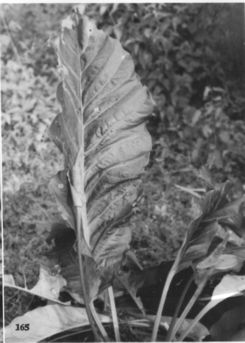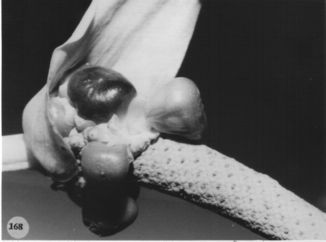





Selbyana 5 (3-4): 333. 1981. TYPE: El Salvador. Ahuachapan; 1.5 miles SW ofTacuba on road to San Francisco Menendez; riverbank, Río Chokama, 700 m elev. Croat 42169 (MO-2583750, holotype; CAS, F, ITIC, K, SEL, US, isotypes; Live at MO).
LEAVES erect-spreading; petioles ± quadrangular, 11-22 cm long, 6-8 mm wide, broadly rounded to slightly 3-ribbed abaxially, broadly and sharply sulcate, sometimes with a medial rib; geniculum 1-1.5 cm long; blades elliptic to ob-lanceolate, medium thick, gradually acuminate at apex, turned downward (the acumen ca. 1.5 cm long), obtuse to rounded and auriculate at base, 25-50 cm long, 8-26 cm wide, broadest at or above the middle; upper surface matte to semiglossy, lower surface matte; midrib obtusely raised above, diminishing and sunken at apex, convexly raised below, ribbed near base; primary lateral veins 8-14 per side, departing midrib at ca. 45° angle, raised at midrib, diminishing and sunken near margin above, prominently raised below, straight to near margin, loop-connected in upper half; lesser veins flat above, raised below; collective vein arising from middle or above, ca. 5 mm from margin, sunken above, raised below.
INFLORESCENCE erect-spreading; peduncle 13-45 cm long, 5-7 mm diam., faintly striate, 1-ribbed adaxially and sometimes abaxially, longer than petioles; spathe ovate-lanceolate, medium thick, pale green (B & K Yellow-green 8/10), held erect, enshrining and wrapped around base of spadix, 4.5-6.5 cm long, 2.4-2.7 cm wide, broadest just above base, narrowly acute, inserted at 10°-25° angle on peduncle; spadix pale green (B & K Green 8/5), 2.5-6.5 cm long, 8-12 mm diam. at base, 4-7 mm diam. at apex, held at a slight angle from the peduncle; flowers ± irregularly 4-lobed, 2-3.3 mm long, 2.5-3.6 mm wide, the sides jaggedly sigmoid; ca. 10 flowers visible in the principal spiral, ca. 9 flowers visible in the alternate spiral; tepals matte, densely papillate, lateral tepals 1.4-1.7 mm wide, turned up against emerging pistil; pistils weakly emergent, green; the stigma elliptic, ca. 0.4 mm long, erect and brushlike, with a small droplet apparent 2-4 days before first stamens emerge; stamens emerging rapidly in a complete progression from the base, lateral stamens emerging at apex when the third and fourth stamens are emerging at the base; anthers pale green, 0.8-1.2 mm long, 0.7-1.3 mm wide, held in a close, contiguous circle around and over the stigma, held at about the same height as the style; thecae weakly divaricate; pollen pale yellow, soon fading white.
INFRUCTESCENCE spreading; spathe persisting and erect; the spadix to 9 cm long, ca. 2 cm diam.; berries broadly obovoid, 5.5-9 mm long, 4-9 mm wide, rounded to flat or weakly indented at apex, orange-red (B & K Yellow-red 5/2.5 to Red 4/10); pericarp moderately thick, with dense punctiform raphide cells, especially in apical half; mesocarp pulpy or mealy with numerous raphide cells; seeds 1 or 2, obovoid to broadly obovoid, yellowish-while to tan, 6-6.5 mm long and 5-5.8 mm wide, 3 mm thick, densely covered with punctiform raphide cells. Figs. 165 and 168.
Anthurium salvadorense is known only from El Salvador and Guatemala at 500 to 800 m elevation. It was first collected by Sislo Alberlo Padilla in 1922 in the Department ofAhuacapan in El Salvador. The species was later collected by Paul C. Standley in the adjacent Department ofJutiapa in Guatemala.
The species is a typical member of section Pachyneurium and the earlier collections were confused with A. schlechtendalii, to which it is related. Anthurium salvadorense is distinguished by being usually a well rooted plant with fewer, very large fleshy roots and a usually almost elliptic blade, but especially by its inflorescence, which has a pale green, ovate-lanceolate spathe that is weakly convolute at the base and erect, enshrining the usually short, pale green spadix. Anthurium schlechtendalii differs in having usually oblanceolate blades, a coriaceous, more lanceolate, prominently reflexed, usually purplish spathe, and a more elongate, purplish spadix.
 |
 |
Map of Mesoamerican specimens with coordinates
El Salvador Ahuachapan: Río Chokama, 700 m,, 28 July 1977, Thomas
B. Croat 42169 (CAS, F, ITIC, K, LE, M, MEXU, MO, RSA, SEL, TEX, US). El
Salvador Ahuachapan:, 22 Nov. 1977, Bernhardt s.n. (MO).
El Salvador Ahuachapan: 500 m,, 28 July 1977, Thomas B. Croat 42092
(B, BM, MO, RSA, U, W).
El Salvador Ahuachapan: 850 m, 13.49N 89.56W, 12 Nov. 1991, Villacorta
937 (MO).
El Salvador Ahuachapan: El Imposible, 13.49N 89.56W, 15 Feb. 1993,
Sandoval & Chinchilla 1000 (B, LAGU, MO).
El Salvador Ahuachapan: El Imposible, 600 m, 13.49N 89.56W, 21 May
1993, Sandoval & Perez 1262 (B, LAGU, MO).
Guatemala Jutiapa: Monjoy Canyon, 530 ft,, 27 July 1979, Dunn et al.
19 (MO).
Guatemala Jutiapa:, , Standley 76313 (F, US).
Guatemala Jutiapa: 1600 ft,, 27 Jul 1979, Dunn et al. 23222 (UMO).
Guatemala Jutiapa: San Cristobal, 533 m.,, 27 jul 1979, 23222 (UMO
154249).